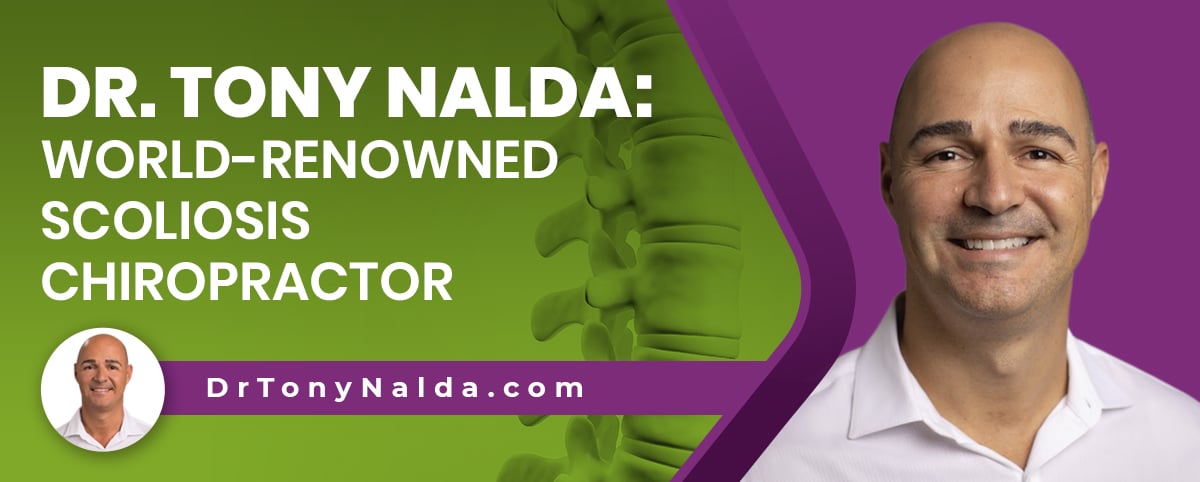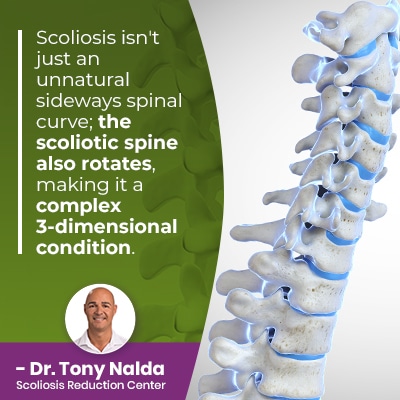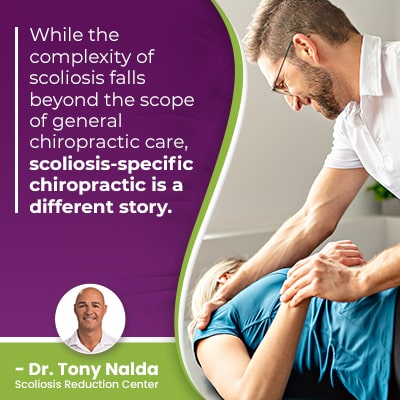Dr. Tony Nalda: World-Renowned Scoliosis Chiropractor

There is more than one approach to treating scoliosis, and while traditional treatment can funnel patients towards spinal fusion surgery, Dr. Tony Nalda offers a nonsurgical treatment option, with proven results. Continue reading to understand the difference between general chiropractic care and scoliosis-specific chiropractic care.
People travel from around the world to benefit from Dr. Tony Nalda's conservative scoliosis treatment approach. As a leading scoliosis chiropractor, Dr. Tony established the Scoliosis Reduction Center and is dedicated to increasing awareness of the highly-prevalent spinal condition.
Dr. Tony's story is unique, so let's start with the path that led him to becoming a world-renowned scoliosis chiropractor.
Table of Contents
Dr. Tony's Inspiration
Some of the best careers are inspired by personal experience, and this is the case with Dr. Tony Nalda who, as an adolescent, struggled with debilitating migraines.
After general medicine couldn't help him, and his migraine severity and frequency was interfering with school, and his much-loved sports, he ended up in a chiropractor's office.
After determining that the underlying cause of his migraines was a spinal misalignment, Dr.Tony's eyes were opened to the power of chiropractic, and the difference between treating symptoms of a condition, or the underlying condition itself.
This was a life-changing moment that put him on the path to where he is today: helping thousands of people master their scoliosis, while rewriting the narrative around a highly-prevalent, and often misunderstood, condition.
After years of working as a general chiropractor, he thought more could be done for scoliosis patients and learned that there was, indeed, a scoliosis-specific chiropractic approach that integrated multiple forms of treatment to impact scoliosis on every level.
After witnessing success with this method, he set out to learn everything he could about various conservative approaches to treating scoliosis and was trained and certified in multiple modalities: CLEAR, SEAS, ISICO, Gomez Orthotics, Chiropractic Biophysics, ScoliBrace and more.
During this journey, Dr. Tony wrote Scoliosis Hope to help address a lot of the misconceptions about scoliosis, and scoliosis treatment, that swirl around the highly-complex condition, and he also wanted patients to know that surgery isn't their only treatment option.
So why is it that scoliosis is so often deemed a complex condition?
What Makes Scoliosis Complex to Treat?
 Scoliosis isn't just an unnatural sideways spinal curve; the scoliotic spine also rotates, making it a complex 3-dimensional condition.
Scoliosis isn't just an unnatural sideways spinal curve; the scoliotic spine also rotates, making it a complex 3-dimensional condition.
Scoliosis is diagnosed when the unnatural curve is of a minimum size: Cobb angle measurement of at least 10 degrees.
A patient's Cobb angle is determined during X-ray by drawing lines from the tops and bottoms of the most-tilted vertebrae, and the intersecting angle is expressed in degrees.
Cobb angle tells me how far out of alignment a scoliotic spine is, and places conditions on a severity scale:
- Mild scoliosis: Cobb angle measurement of between 10 and 25 degrees
- Moderate scoliosis: Cobb angle measurement of between 25 and 40 degrees
- Severe scoliosis: Cobb angle measurement of 40+ degrees
- Very-severe scoliosis: Cobb angle measurement of 80+ degrees
Condition severity shapes the design of effective and customized treatment plans, and this is where scoliosis-specific care delivered by a specialist is important.
In addition to scoliosis ranging widely in severity and being a complex structural 3-dimensional spinal condition, there are also different types of scoliosis a person can develop, and scoliosis is also progressive.
The main form of scoliosis is idiopathic scoliosis, and while we don't fully understand what causes this type, it accounts for approximately 80 percent of known diagnosed scoliosis cases, and the remaining 20 percent are associated with known causes: neuromuscular scoliosis, degenerative scoliosis, and congenital scoliosis.
Adolescent idiopathic scoliosis, diagnosed between the ages of 10 and 18, is the most-prevalent type of scoliosis overall, so we'll focus on this type for our current purposes.
Scoliosis has it in its nature to worsen over time, so where a scoliosis is at the time of diagnosis is not indicative of where it will stay; only proactive treatment can work towards counteracting the condition's progressive nature.
This is the benefit of a proactive treatment approach; I believe in starting treatment as close to the time of diagnosis as possible to work towards preventing progression.
While there are never treatment guarantees, early detection and early intervention does increase the likelihood of treatment success.
Scoliosis is simplest to treat early in its progressive line, before the spine has gotten more rigid with progression, making it less responsive to treatment, before significant muscle imbalance has developed alongside progression, and before the body has had ample time to adjust to the unnatural spinal curve's presence.
So how can a chiropractor fix scoliosis?
Can a Chiropractor Fix Scoliosis?
 While the complexity of scoliosis falls beyond the scope of general chiropractic care, scoliosis-specific chiropractic is a different story.
While the complexity of scoliosis falls beyond the scope of general chiropractic care, scoliosis-specific chiropractic is a different story.
This difference is the lesson I learned during my migraine care, when my migraines stopped being treated as a symptom, and their underlying cause, my spinal misalignment was addressed.
If a person with scoliosis sees a general chiropractor, they can receive some symptom relief, short-term pain relief, but this means a person with scoliosis is being treated, but not the scoliosis itself, and this is a key distinction.
While scoliosis pain can be relieved with some manipulative and rehabilitative therapy, in order to impact scoliosis on every level, as it needs to be for treatment success, a scoliosis chiropractor has to integrate multiple forms of treatment into customized treatment plans.
A scoliosis chiropractor knows the spine, and knows scoliosis, and knows how the spine responds to different types of treatment.
Chiropractic Care
Here at the Scoliosis Reduction Center, scoliosis-specific chiropractic care is used to impact scoliosis on a structural level primarily, as the underlying nature of scoliosis is structural; this is worked towards through a series of chiropractic techniques including chiropractic adjustments and manual therapy that address areas of vertebral subluxation.
As a curve's most-tilted vertebrae are repositioned back into alignment with the rest of the spine, its healthy curves are being restored, as are the spine's biomechanics, and as a scoliotic curve is reduced in size, so are the condition's effects.
Now, as a scoliosis chiropractor, I understand that in order to fix scoliosis, adjusting the spine isn't enough; more treatment has to be applied to impact it on every level.
Physical Therapy
Through physical therapy and the application of scoliosis-specific exercises (SSEs), the muscles surrounding the spine are strengthened so they can optimally support the spine and address any related muscle imbalance that has developed.
If the muscles surrounding the spine are strong, it takes pressure off the spine and its individual parts, such as the spinal discs, and this facilitates the spine's ability to maintain its natural curves and alignment.
Physical therapy and scoliosis-specific exercises can also improve brain-body communication by activating certain areas of the brain necessary for postural remodeling and achieving a more natural body positioning.
Corrective Bracing
Corrective bracing can also be an important facet of treatment, particularly on growing spines, by pushing the spine into a corrective position, while providing the spine with support and stabilization.
Traditional scoliosis bracing is associated with a number of shortfalls, mainly because it only addresses scoliosis on 2 dimensions, ignoring its complex 3-dimensional nature and rotational component.
Rehabilitation
Rehabilitation is also needed to hold the reduction where it is for long-term sustainable treatment results, and this involves the prescription of customized exercises to help patients establish a home-rehabilitation program to further stabilize the spine.
So as you can see, treating scoliosis conservatively means addressing its underlying structural nature, but doesn't just rely on one form of treatment; its complex nature necessitates the integration of multiple scoliosis-specific treatment disciplines to impact the condition on every level.
Conclusion
When it comes to addressing an abnormal curvature of the spine, scoliosis treatment has to be designed and delivered by a specialist to ensure the complex nature of the condition is fully understood.
Chiropractic treatment has the potential to impact scoliosis on a structural level in the form of a curvature reduction, and as the scoliotic spinal curvature is reduced in size, its progression is being managed proactively.
Once structural treatment results have been achieved, shifting the focus to increasing core strength so the spine can be optimally supported by its surrounding muscles is key.
Corrective bracing can help augment corrective results by pushing the spine into a healthier position, and a series of custom-prescribed home exercises can work towards further stabilizing the spine through rehabilitation.
Dr. Tony Nalda offers patients a nonsurgical conservative treatment option, with proven results, that many traverse the globe for.
It's Dr. Tony's highly-specific and integrative treatment approach that continues to give scoliosis patients hope: hope that they can not just live with scoliosis, but thrive with it, and maintain a positive quality of life throughout treatment and beyond.
Dr. Tony Nalda
DOCTOR OF CHIROPRACTIC
After receiving an undergraduate degree in psychology and his Doctorate of Chiropractic from Life University, Dr. Nalda settled in Celebration, Florida and proceeded to build one of Central Florida’s most successful chiropractic clinics.
His experience with patients suffering from scoliosis, and the confusion and frustration they faced, led him to seek a specialty in scoliosis care. In 2006 he completed his Intensive Care Certification from CLEAR Institute, a leading scoliosis educational and certification center.
About Dr. Tony Nalda
 Ready to explore scoliosis treatment? Contact Us Now
Ready to explore scoliosis treatment? Contact Us Now





